St Mark's Basilica - Venice
Aug 30, 2019 09:26:38 #
Wikipedia:
The Patriarchal Cathedral Basilica of Saint Mark (Italian: Basilica Cattedrale Patriarcale di San Marco), commonly known as St Mark's Basilica (Italian: Basilica di San Marco; Venetian: Baxéłega de San Marco), is the cathedral church of the Roman Catholic Archdiocese of Venice, northern Italy. It is the most famous of the city's churches and one of the best known examples of Italo-Byzantine architecture. It lies at the eastern end of the Piazza San Marco, adjacent and connected to the Doge's Palace. Originally it was the chapel of the Doge, and has been the city's cathedral only since 1807, when it became the seat of the Patriarch of Venice,[1] archbishop of the Roman Catholic Archdiocese of Venice, formerly at San Pietro di Castello.[2]
Detail of the gable showing Venice's patron apostle St. Mark with angels. Underneath is a winged lion, the symbol of the saint and of Venice.
The basic structure of the church dates from roughly 1060 to 1100, and the large amount of subsequent work has essentially been to embellish this rather than replace elements. The famous main facade has an ornamented roofline that is mostly Gothic, and the gold ground mosaics that now cover almost all the upper areas of the interior took centuries to complete. In the 13th century the external height of the domes was greatly increased by hollow drums raised on a wooden framework and covered with metal; the original ones are far more shallow, as can be seen on the inside.[3] Without this, they would not now be visible from the piazza.
For its opulent design, gold ground mosaics, and its status as a symbol of Venetian wealth and power, from the 11th century on the building has been known by the nickname Chiesa d'Oro (Church of gold).[4] It achieves an Oriental feeling of exoticism, partly through blending Byzantine and Islamic elements, but remains unique, and essentially a product of Italian workers of all sorts
History
Earliest construction
Original facade of St. Mark's Basilica
Plan diagram, showing different phases of construction
Lithography 1857 year
The first St Mark's was a building next to the Doge's Palace, ordered by the doge in 828, when Venetian merchants stole the relics that were traditionally considered to be that of Mark the Evangelist from Alexandria, and completed by 832; from the same century dates the first St Mark's Campanile (bell tower). The church was burned in a rebellion in 976, when the populace locked Pietro IV Candiano inside to kill him, and restored or rebuilt in 978. Nothing certain is known of the form of these early churches. From perhaps 1063[6] the present basilica was constructed. The consecration is variously recorded as being in 1084–85, 1093 (the date most often taken), 1102 and 1117, probably reflecting a series of consecrations of different parts.[7] The size of the church was increased in all directions, especially to the north and south, and the wooden domes replaced by brick, which required thickening such walls as were retained.[8]
In 1094 the body Considered Traditionally to be that of Saint Mark was rediscovered in a pillar by Vitale Faliero, doge at the time.[9] The building also incorporates a low tower (now housing St Mark's Treasure), believed by some to have been part of the original Doge's Palace. The Pala d'Oro ordered from Constantinople was installed on the high altar in 1105.[10] In 1106 the church, and especially its mosaics, were damaged by a serious fire in that part of the city; it is not entirely clear whether any surviving mosaics in the interior predate this, though there is some 11th-century work surviving in the main porch.[11] The main features of the present structure were all in place by then, except for the narthex or porch, and the facade.
The basic shape of the church has a mixture of Italian and Byzantine features, notably "the treatment of the eastern arm as the termination of a basilican building with main apse and two side chapels rather than as an equal arm of a truly centralized structure".[12] In the first half of the 13th century the narthex and the new facade were constructed, most of the mosaics were completed and the domes were covered with second much higher domes of lead-covered wood in order to blend in with the Gothic architecture of the redesigned Doge's Palace.
As with most Venetian buildings, the main structure is built in brick, with the arches given moulded terracotta or brick decoration, with stone columns, capitals, horizontal mouldings, and some other details. The brick mostly remains in place, but covered over except in a few places.[13]
Later construction
The basic structure of the building has not been much altered. Its decoration has changed greatly over time, though the overall impression of the interior with a dazzling display of gold ground mosaics on all ceilings and upper walls remains the same. The original unadorned structure would probably have looked very different, but it is likely that gradual decoration was always intended.[14] The succeeding centuries, especially the period after the Venetian-led conquest of Constantinople in the Fourth Crusade of 1204 and the fourteenth century, all contributed to its adornment, with many elements being spolia brought in from ancient or Byzantine buildings, such as mosaics, columns, capitals, or friezes.[15] The Venetian sculptors of other capitals and friezes copied the Byzantine style so effectively that some of their work can only be distinguished with difficulty.[16] Gradually, the exterior brickwork became covered with marble cladding and carvings, some much older than the building itself,[17] such as the statue of the Four Tetrarchs (below).
The latest structural additions include the closing-off of the Baptistery and St Isidor's Chapel (1300s), the carvings on the upper facade and the Sacristy (1400s), and the closing-off of the Zen Chapel (1500s).
Hi,
This Basilica is located in St Mark's square. From the top of the Church you also can view part of Venice, but for a better view you need to take the elevator to the observation deck of the St Mark's bell tower (ticket).
Hope you enjoy!
The Patriarchal Cathedral Basilica of Saint Mark (Italian: Basilica Cattedrale Patriarcale di San Marco), commonly known as St Mark's Basilica (Italian: Basilica di San Marco; Venetian: Baxéłega de San Marco), is the cathedral church of the Roman Catholic Archdiocese of Venice, northern Italy. It is the most famous of the city's churches and one of the best known examples of Italo-Byzantine architecture. It lies at the eastern end of the Piazza San Marco, adjacent and connected to the Doge's Palace. Originally it was the chapel of the Doge, and has been the city's cathedral only since 1807, when it became the seat of the Patriarch of Venice,[1] archbishop of the Roman Catholic Archdiocese of Venice, formerly at San Pietro di Castello.[2]
Detail of the gable showing Venice's patron apostle St. Mark with angels. Underneath is a winged lion, the symbol of the saint and of Venice.
The basic structure of the church dates from roughly 1060 to 1100, and the large amount of subsequent work has essentially been to embellish this rather than replace elements. The famous main facade has an ornamented roofline that is mostly Gothic, and the gold ground mosaics that now cover almost all the upper areas of the interior took centuries to complete. In the 13th century the external height of the domes was greatly increased by hollow drums raised on a wooden framework and covered with metal; the original ones are far more shallow, as can be seen on the inside.[3] Without this, they would not now be visible from the piazza.
For its opulent design, gold ground mosaics, and its status as a symbol of Venetian wealth and power, from the 11th century on the building has been known by the nickname Chiesa d'Oro (Church of gold).[4] It achieves an Oriental feeling of exoticism, partly through blending Byzantine and Islamic elements, but remains unique, and essentially a product of Italian workers of all sorts
History
Earliest construction
Original facade of St. Mark's Basilica
Plan diagram, showing different phases of construction
Lithography 1857 year
The first St Mark's was a building next to the Doge's Palace, ordered by the doge in 828, when Venetian merchants stole the relics that were traditionally considered to be that of Mark the Evangelist from Alexandria, and completed by 832; from the same century dates the first St Mark's Campanile (bell tower). The church was burned in a rebellion in 976, when the populace locked Pietro IV Candiano inside to kill him, and restored or rebuilt in 978. Nothing certain is known of the form of these early churches. From perhaps 1063[6] the present basilica was constructed. The consecration is variously recorded as being in 1084–85, 1093 (the date most often taken), 1102 and 1117, probably reflecting a series of consecrations of different parts.[7] The size of the church was increased in all directions, especially to the north and south, and the wooden domes replaced by brick, which required thickening such walls as were retained.[8]
In 1094 the body Considered Traditionally to be that of Saint Mark was rediscovered in a pillar by Vitale Faliero, doge at the time.[9] The building also incorporates a low tower (now housing St Mark's Treasure), believed by some to have been part of the original Doge's Palace. The Pala d'Oro ordered from Constantinople was installed on the high altar in 1105.[10] In 1106 the church, and especially its mosaics, were damaged by a serious fire in that part of the city; it is not entirely clear whether any surviving mosaics in the interior predate this, though there is some 11th-century work surviving in the main porch.[11] The main features of the present structure were all in place by then, except for the narthex or porch, and the facade.
The basic shape of the church has a mixture of Italian and Byzantine features, notably "the treatment of the eastern arm as the termination of a basilican building with main apse and two side chapels rather than as an equal arm of a truly centralized structure".[12] In the first half of the 13th century the narthex and the new facade were constructed, most of the mosaics were completed and the domes were covered with second much higher domes of lead-covered wood in order to blend in with the Gothic architecture of the redesigned Doge's Palace.
As with most Venetian buildings, the main structure is built in brick, with the arches given moulded terracotta or brick decoration, with stone columns, capitals, horizontal mouldings, and some other details. The brick mostly remains in place, but covered over except in a few places.[13]
Later construction
The basic structure of the building has not been much altered. Its decoration has changed greatly over time, though the overall impression of the interior with a dazzling display of gold ground mosaics on all ceilings and upper walls remains the same. The original unadorned structure would probably have looked very different, but it is likely that gradual decoration was always intended.[14] The succeeding centuries, especially the period after the Venetian-led conquest of Constantinople in the Fourth Crusade of 1204 and the fourteenth century, all contributed to its adornment, with many elements being spolia brought in from ancient or Byzantine buildings, such as mosaics, columns, capitals, or friezes.[15] The Venetian sculptors of other capitals and friezes copied the Byzantine style so effectively that some of their work can only be distinguished with difficulty.[16] Gradually, the exterior brickwork became covered with marble cladding and carvings, some much older than the building itself,[17] such as the statue of the Four Tetrarchs (below).
The latest structural additions include the closing-off of the Baptistery and St Isidor's Chapel (1300s), the carvings on the upper facade and the Sacristy (1400s), and the closing-off of the Zen Chapel (1500s).
Hi,
This Basilica is located in St Mark's square. From the top of the Church you also can view part of Venice, but for a better view you need to take the elevator to the observation deck of the St Mark's bell tower (ticket).
Hope you enjoy!
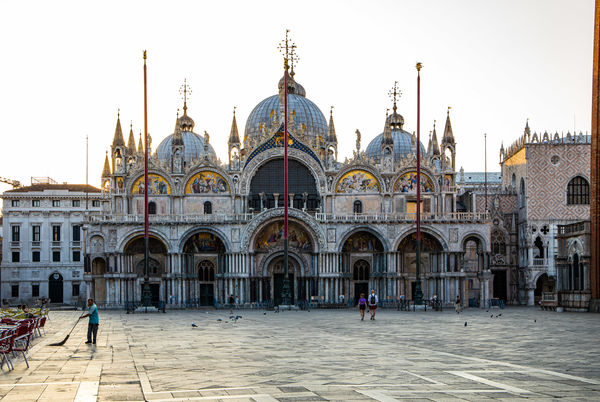
(Download)
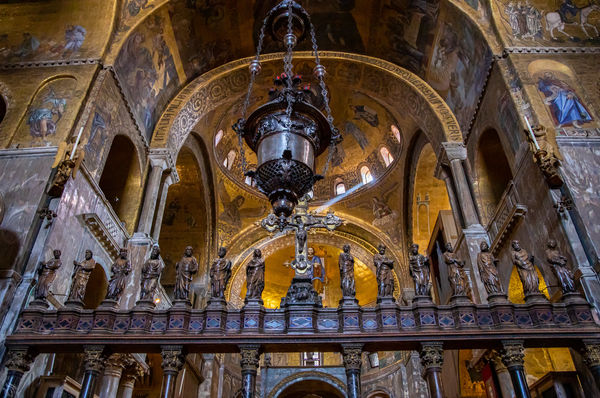
(Download)
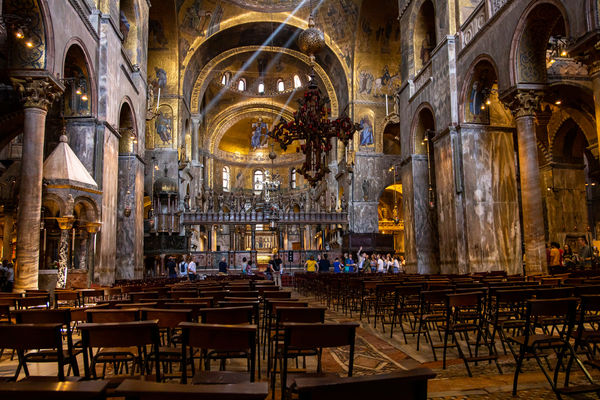
(Download)
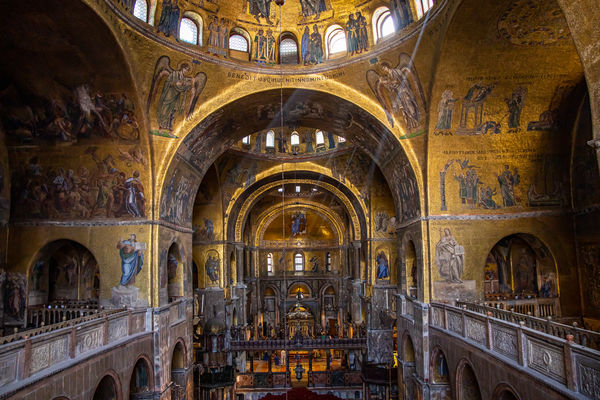
(Download)
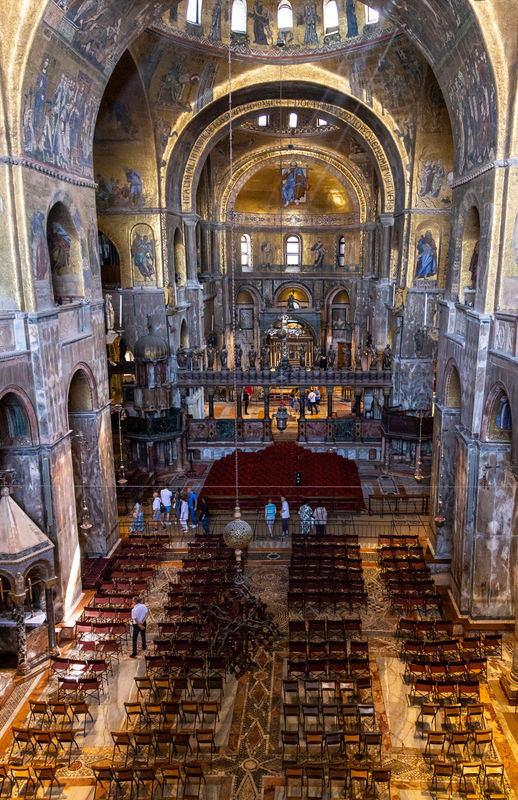
(Download)
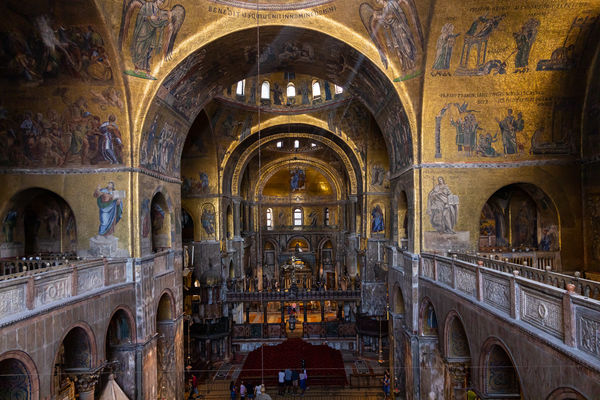
(Download)
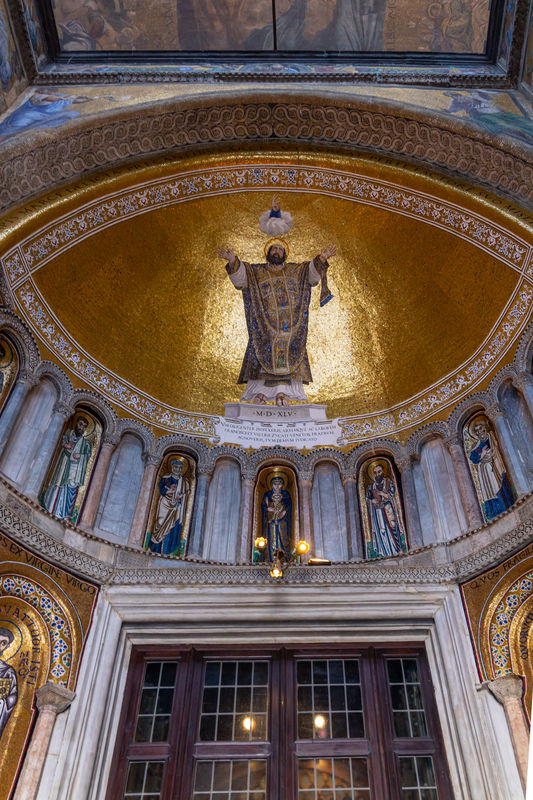
(Download)
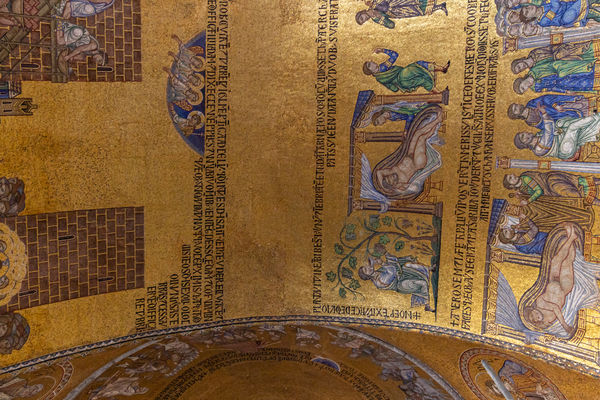
(Download)
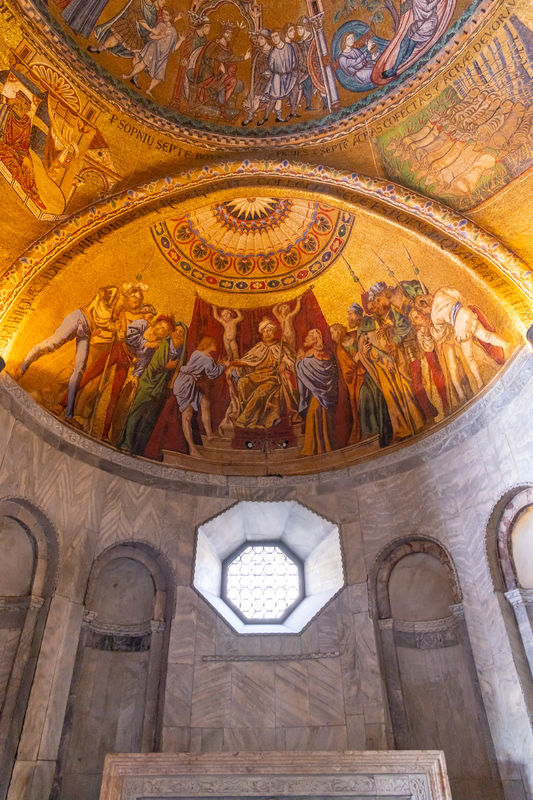
(Download)
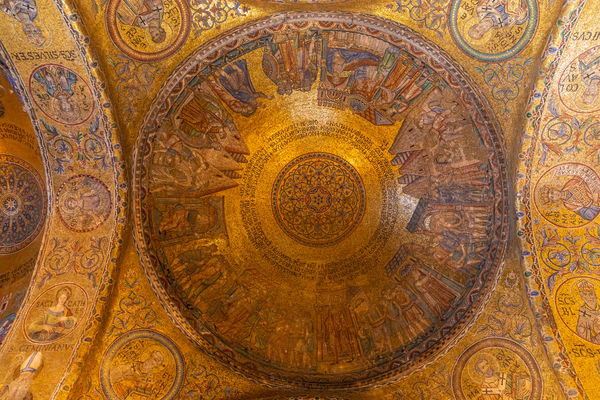
(Download)
Aug 30, 2019 09:36:42 #
Aug 30, 2019 09:43:09 #
GreyOwl40
Loc: Quebec City
Saigon, great set! What an incredible structure. I was surprised by the seating; not what I expected.
Aug 30, 2019 09:45:43 #
Aug 30, 2019 09:48:15 #
GreyOwl40 wrote:
Saigon, great set! What an incredible structure. I was surprised by the seating; not what I expected.
Thanks GreyOwl40! Yes, it is very strange for a church.
Aug 30, 2019 09:54:58 #
St Marks Square is what I consider to be the most beautiful square in the world. Again you have incredibly beautiful captures. #1 is singularly impressive.
Aug 30, 2019 10:08:51 #
On our visit a few years ago the square was somewhat under water and we had to use a walkway made up of raised boards set on platforms. I agree it is a spectacular place.
Aug 30, 2019 10:13:27 #
timcc
Loc: Virginia
Very nice shots! When we were there a few years ago, half the church was covered with scaffolding, so it's good to see the finished facade.
Aug 30, 2019 10:19:09 #
Aug 30, 2019 12:17:50 #
Saigon wrote:
Wikipedia: br br The Patriarchal Cathedral Basili... (show quote)
You hit it out of the park with these, Saigon; wonderfully captured and framed.


Aug 30, 2019 12:33:53 #
Hereford wrote:
St Marks Square is what I consider to be the most beautiful square in the world. Again you have incredibly beautiful captures. #1 is singularly impressive.
Thanks Hereford! I love they play music along the Arch in the square - It is such a unique place indeed.
Aug 30, 2019 12:35:12 #
SpikeW wrote:
On our visit a few years ago the square was somewhat under water and we had to use a walkway made up of raised boards set on platforms. I agree it is a spectacular place.
Yes, They worry about the global warming effect in Venice which could raise the water level on the island.
Thx SpikeW!
Aug 30, 2019 12:35:37 #
Earnest Botello wrote:
Very good series, Saigon.
Thx Earnest Botell, glad you enjoyed.
Aug 30, 2019 12:36:06 #
Rob48 wrote:
You hit it out of the park with these, Saigon; wonderfully captured and framed. 



Thx Rob48! Much appreciated....

Aug 30, 2019 12:57:28 #
Saigon wrote:
Thanks GreyOwl40! Yes, it is very strange for a church.
When I was stationed in Europe, most churches did not have seats, just standing room.
If you want to reply, then register here. Registration is free and your account is created instantly, so you can post right away.





